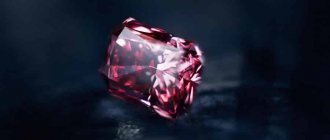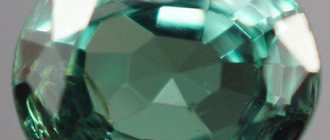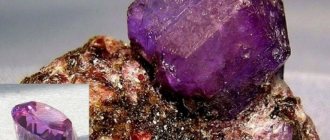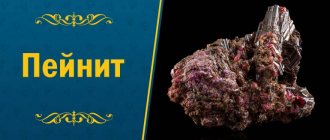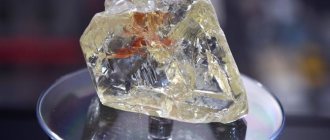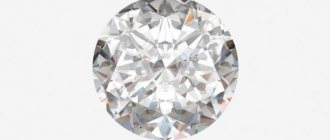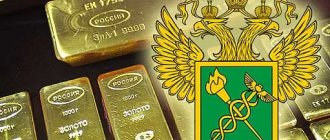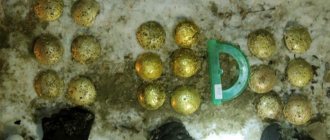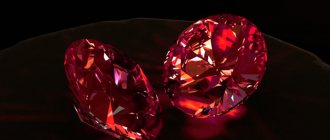Yakhont is a mysterious and multifaceted stone; this is what some gems were called in the old days and is still called by people. In an attempt to unravel the mystery of the gem, let's look to the past.
At all times, a large number of legends, tales and fables hovered around precious stones, which left a trail of old stories about the Yakhont stone. Nowadays, this is more a literary than an everyday name for stone jewelry, but not everyone is ready to forget this attractive word.
Many-faced stone: what are yachts
The word Yakhont was used to describe shiny stones with a distinct color. It is believed that this name comes from the Persian word "Yakut". And the latter, according to historians, comes from the Greek term “yakinthos” - that is, “hyacinth” - bright, shining and brilliant.
Today, few people will be surprised by jewelry with stones. It was a different matter in the old days: there were few open deposits, gems were mined without the help of complex mechanisms, expensive stones were not only an attribute of luxury, but were simply rare for ordinary people. So the rare stone was a wonder of jewelry for the people.
The value of some crystals was so high that especially large specimens were given proper names, and the attributes of rulers of peoples and countries were decorated with them. For example, Monomakh’s hat is decorated with yakhonts (there are blue, yellow, and red gems set in gold). The Great Imperial Crown of the Russian Empire has a red stone on top. The azure yacht crowns the crown of the Austrian Empire. Scroll through the photos of crowns:
Great Crown of the Russian Empire
Monomakh's hat, photo: interesnyefakty.org
Crown of Charlemagne
Crown of the Austrian Empire, photo: Dennis Jarvis, flickr.com
Crown of the Bavarian kings, photo: foter.com
What minerals were called yakhonts in the old days
Until the 19th century, all minerals of the corundum family (and not only) were called yakhont or lal, distinguishing subspecies according to the colors and shades of the mineral.
A detailed description of what color yachts are can be found in the translated texts of the greatest Armenian historian of the 17th century, Arakel Davrizhetsi:
- The ruby gemstone was called red and scarlet yacht, as well as padparadscha, spinel, garnet (7 half-tones of the stone were distinguished: the color of vinegar, wine must, purple, garnet, balkha, as well as sedimentary and lilac shades);
- Tourmalines of pink, red and crimson shades were also called red;
- And what kind of stone was called “azure yakhont” in the old days - sapphire. In Rus', the blue gem was called azure, thanks to its smooth and shiny blue surface, similar to the azure of a clear sky on a sunny day. Such a stone was divided into 5 subspecies according to color, comparing them with olives, the sea, clear daytime skies, evening and night skies;
- Cherry yakhont is an amethyst (although it does not belong to corundum, it was called yakhont);
- Hyacinth was called yellow (there were 4 types of tone - straw, wax, citrus and crystal). In ancient times, these gems were valued lower than their counterparts; they were figuratively said to be “still immature.”
However, there was no consensus throughout the world about whether specific minerals belonged to corundum. In the process of wandering through different languages and dialects, the word acquired various additions. It was the confusion that led scientists to decide to disown the inaccurate term.
Story
There is still debate about where the name of these stones came from. According to some historians, the word “sapphire” comes from the language of ancient Babylon from “spira”, which means “scratching”. It is the hardness of sapphire that most likely gave rise to its name. Another, more poetic version traces the origin of the word to the ancient Indian language, to the word “caniprya” (beloved of Saturn). In Hellas, "sappheiros" was the name for all dark blue colored gemstones. There are other names for sapphires in history. So, until the 19th century in Russia they were called azure yachts, lapis lazuli.
The most famous sapphire jewelry, decorated with large and clear stones, belongs to the ruling dynasties of Europe and Asia. The brooch, which belonged to the Indian Maharaja, was made from a 4,000-carat gem. The power of the Russian emperors is decorated with a stone half as large. Since ancient times, the sapphire gemstone has meant its owner’s direct relationship to power and control of a large number of people.
A large blue stone of 167 carats, cut into the shape of a rose, adorns the crown of the British Empire. The cut of sapphires can be different. For example, another world-famous jewel belonging to the English royal family is Princess Diana's engagement ring, which is now worn by the Duchess of Cambridge, née Kate Middleton. The ring features an oval Ceylon corundum surrounded by diamonds. By the way, sapphires were generally one of Lady Di’s favorite stones, who adored all shades of dark blue.
The collection of the Orange dynasty, ruling in the Netherlands, included a parure that included massive jewelry trimmed with sapphires and diamonds. Now many of the decorations from this set have been converted into more modern ones.
The tradition of decorating the jewelry of rulers with corundum dates back to ancient times. According to legend, these beautiful stones were inserted into the crown of Cleopatra herself.
Officially: in explanatory dictionaries of the Russian language
Explanatory dictionaries of the Russian language describe in detail what “yakhonty” means:
- Dahl's large dictionary of the living Great Russian language (compiled in the middle of the 19th century) reads - “lal, ruby. Yakhont is worm-shaped (crimson-blue), red, actually a ruby. Yakhont is blue, blue is sapphire. The following are not yachts at all: cherry - amethyst; yellow - hyacinth." That is, according to Vladimir Ivanovich Dahl, an expert on Russian literature, cherry and yellow varieties of gems are called so figuratively, for example, as an analogy one can recall the “tiger eye” stone, which has nothing to do with the huge cats themselves, except for external similarity.
- The dictionary compiled by the Soviet linguist Sergei Ivanovich Ozhegov (first edition in 1949) mentions “the name of ruby and sapphire in the old days.” The definition is given briefly, without details, and an example of the use of the word is given in a figurative sense: “The eyes burn like yachts.” That is, there is a lack of information in the mid-20th century about the use of the term in its direct meaning.
We see the same in the dictionary edited by D.N. Ushakov, 1935 edition - “Interpretation of ruby and sapphire in antiquity.” “The Fable of the Fox and the Grapes” by I. A. Krylov is also mentioned there. “...The hungry godfather Fox climbed into the garden; The bunches of grapes in it were red. The gossip's eyes and teeth flared up; And the brushes are juicy, like yachts, burning...”
Notes
- ↑ 123456789101112131415
[kristallov.net/kamni_na_bukvu_a.html A / Dictionary of minerals and rocks] - ↑ 12345678910
[kristallov.net/b3.html B // Dictionary of minerals and rocks] - ↑ 1234
[kristallov.net/v3.html В/Dictionary of minerals and rocks] - [kristallov.net/g3.html G / Dictionary of minerals and rocks]
- ↑ 12345678910
Error in footnotes: Invalid tag ; no text specified for footnotes .D0.B3 - ↑ 1234
[kristallov.net/d3.html D / Dictionary of minerals and rocks] - [www.vostlit.info/Texts/Dokumenty/China/XVII/1600-1620/Russ_kit_otn_17_v_I/glossar.htm Terminological dictionary]
- [www.rubricon.com/qe.asp?qtype=4&qall=0&aid={8211B08E-1793-45F2-9232-917AE585C51D}&ii=1&id=1&sletter=%u042F&rq=0&onlyname=checked&newwind=&psize=10&pn=63 Yakhont]. Great Soviet Encyclopedia
. - [samlib.ru/r/rusanow_wladislaw_adolfowich/kamni.shtml Outdated names of minerals]
“Yakhontovy”, what is it?
The expressions “you are my yacht,” “yakhon eyes” have been preserved to this day.
The phrases deeply and thoughtfully emphasize that they say this to people who are dearly loved, dear to the heart on the one hand, and on the other, unattainable, not belonging in soul to the speaker. As a striking example, I remember Baba Yaga from the cartoon “The Adventures of Little Brownie Kuzi”, who exclaimed “You are my Yakhontovy”, according to the plot she understands that she will not be able to keep Kuzma in her mansion, but she will try to the last.
And they make a compliment about the eyes, uttering the words “yachon eyes,” pointing to the beauty and vital sparkle of the eyes they like, comparing them with the beauty and shine of expensive jewelry.
Diamond processing
The main stages of processing a natural mineral:
- chipping;
- sawing;
- grinding;
- polishing
At the first stage, parts are broken off from a piece of an indefinite shape, everything that interferes with the beauty of the future product is cut off. The next stage is carried out using diamond powder, as this will make cutting the hardest mineral much easier. Then the master shapes the edges and perfects his work. A properly processed diamond will please the eye, shimmering in different colors in the sun, although it itself is a colorless stone.
Other stones are processed much easier and faster, since they have much less hardness.
In prose and poetry
The word “yakhont” in books of the 19th-20th centuries was used to glorify images similar to a gem and to describe precious stones and jewelry.
The stone, as a true treasure, was mentioned in the writings of poets A. S. Pushkin and S. A. Yesenin, writers I. A. Krylov, A. N. Tolstoy and others. Here are a few quotes using the title in its literal sense:
- “A Guest from Gosha”, Davydov Zinovy. “...The knight rode, looking at the Master, counting the bags on his and his saddle, feeling the stones sewn into the cuffs, in the underfur and in the trim - Venetian yachts, Persian turquoise, large pearls...”
- “The Death of Ivan the Terrible”, A. N. Tolstoy “...Give me that harness with turquoise, with pearls, and with it that saddle cloth that is fattened with yahonts!” ..."
- “I asked the money changers today...”, S. A. Yesenin “... And the money changer answered me briefly: they don’t talk about love in words, they sigh about love only furtively, and their eyes, like yachts, burn...” The eyes, apparently, were compared with a blue gem called the azure yakhont.
Ruby
Ruby is the most beautiful of precious stones, a type of corundum. The color varies from deep pink to fiery crimson and deep red with a purple tint. This shade appears with a chromium content of up to 2%. Ruby is a first class gemstone and one of the most expensive stones in the world. Its chemical formula is Al2O3.
Ruby is associated with the sun, passion, fire and love. In Europe, from time immemorial, it has been a symbol of strength, beauty, devotion to faith, dignity and courage. In the East, it represents love, health, strength and vitality. In India, ruby is considered the stone of the Sun.
In the ancient texts of the Bible and Koran
The first mentions of the mineral can be seen in the Bible (Exodus 28:19; Exodus 39:12). The translation of the biblical texts says that the yakhont stone is a precious gem, the third of twelve attached to the chest leather vestment of the high priest.
Casket of the Polish princess Jadwiga Jagiellonka, photo: hermitagemuseum.org
Fragment, photo: hermitagemuseum.org
Photo: Nata-Ko, liveinternet.ru
There is also a mention by Arakel Davrizhetsi about Mount Salandir-Dagi in Ceylon, as if Adam descended on it after his expulsion from Eden, and after which the yahonts began to exist there. And as this Armenian scientist of the 17th century noted in his works, that besides this mountain, these gems cannot be found anywhere else.
In the Koran, the ancient concept is found once in the interpretation of ABU Adel in Sura 88 “The Covering One,” verse 13: “There are beds erected.” The explanation to the sura says the following: “The beds of paradise are made of gold, decorated with chrysolite, pearls and yakhont.”
Aquamarine
Pliny the Elder gave a romantic and very appropriate name to aquamarine. The romantic name “aquamarine” was first used by the ancient Roman historian Pliny the Elder. This unusual gem reminded him of the pure green waters of the sea. Aquamarine - beryllium aluminosilicate with a ring structure - belongs to valuable jewelry stones. One of the largest aquamarines still adorns the crown of the Queen of England, adjacent to diamonds and rubies. This beautiful stone is considered the ruler of the water element, the stone of purposeful and lucky people.
Magical and healing properties
Amirdovlat Amasiatsi, (Armenian naturalist, scientist of the 15th century, personal physician of Sultan Mehmed the Conqueror) pointed out that there are 5 types of yakhont, pompously emphasizing that the nature of the mineral is dry and cold. Preferring the colors of the stone - garnet and red, the author attributed to them the healing properties of helping with a weak heart and palpitations. The doctor advised women who breastfeed their children to wear the gem to maintain lactation.
To improve your mood, it was recommended to take the crystal in your mouth.
He also pointed out the property of harmonizing the body and enlightening the soul with the help of the stone, saying that those who wear it will be attractive to others. But it is quite possible that we were talking about a blue gem, since from other sources it is known that ancient esotericists did not recommend wearing a red yakhont to choleric people, and people prone to passion, violence, and rowdyism. They claimed that lalas, scarlet rubies, contributed to increased mood swings. For this, the red mineral was called the stone of anger.
But about the cherry yakhont, amethyst, they said that when taken into the mouth, a person’s thirst went away. Amethyst was credited with healing properties for many eye diseases.
Be careful if you come across information that supposedly “ground corundum is taken to treat male impotence, eye diseases and colds,” the result of such “treatment” can be disastrous. If, of course, you succeed, you can crush corundum, which is only harder than diamond. Perhaps this is what they did in the Middle Ages.
Remember that as a therapy, the stone is used exclusively in folk medicine. First of all, you need to contact a medical facility and not self-medicate.
Who is suitable according to their zodiac sign?
Astrologers do not advise Capricorns to use blue corundum as a talisman.
Like other stones, this one has its own zodiac favorites. Among the favorites who were lucky enough to be included in the circle of the chosen ones, astrologers name the following zodiac signs:
- Sagittarius . Corundum will give Sagittarius courage. Having tuned in to victory, Sagittarius men will begin to reach new heights. Sagittarius women will become a little more charming, the amulet will give them new mutual affection.
- A lion . Leos should not expect drastic changes in their lives from him. However, the stone will help them work on their character - it will calm down their ardor and relieve irritability.
- Scorpion . Sapphire is like a magic wand for Scorpio. The gem will get rid of the negativity that this sign constantly envelops itself with and will help you choose the direction for development.
In addition, the blue mineral is suitable for Aries, Aquarius , Cancer , Pisces , Libra , Virgo , Taurus , but for Capricorn and Gemini .
Blue corundum is a wonderful talisman for those who want to look beautiful and develop spiritually. It brings good luck, protects its owner from envious people and black magic.
Physical properties of minerals
The physical properties of the stone were described as follows: they suggested throwing it into molten gold, and noted that the gem did not burn or deteriorate, that is, they compared the melting point of the mineral with gold.
The size of a carat of yakhont was compared with 4 grains of wheat.
If we talk about modernity, blue or light blue yacht is a sapphire, and pink is a ruby. Both crystals are corundum, but differ in their chemical component: their base is aluminum oxide, the pink tint is caused by chromium, and the rich blue and violet are due to titanium and iron.
Corundums have a hardness of 9 out of 10 on the Mohs scale, which makes them extremely durable and not subject to mechanical damage.
Production
Sapphire is a stone whose deposits are found on all continents except Antarctica. The most valuable and beautiful of them are considered to be minerals native to India and Tanzania. The island of Ceylon is also a popular place where sapphire is mined. In India, the Kashmir deposit was discovered after an earthquake, which exposed rich deposits of sapphires of amazingly pure, cornflower blue color. This shade is considered the reference shade for blue corundums. Ceylon stone and gems from Burma are approaching him. Now the development of the Kashmir field has been stopped.
In Tanzania, two types of stones are mined, which have received a separate name. Songea and Tunduru are the names of the deposits, which also became the names of the sapphires mined there. Songea are often green or reddish stones, among which there are many minerals with the effect of asterism. It is believed that these corundums have the richest color palette. An interesting feature of songea is its amazing purity, combined with its small size. Songea measuring 2 carats is already a rarity. Tunduru is the only deposit in Tanzania where blue minerals are mined.
Stones from the island of Ceylon (Sri Lanka) are known not only for their quality, but also for their rare properties. Minerals are often mined there that can exhibit asterism after a suitable cut or change color under certain conditions. They often become exhibits in collections in their own right, without being included in a piece of jewelry.
Ceylon is also a place where sapphires, which have a unique pink-orange color, are mined. They are called padparadscha. There is a version that this color of the stone and its name come from the word meaning lotus color. The islanders who first discovered pink sapphires described their color as a cross between a light and delicate lotus petal and a rich Ceylon sunset. Padparadscha, like Tanzanian songeas, rarely reach large sizes. Padparadscha, weighing more than 5 carats, is already a collectible, and the largest of them weighs just over 100 carats and is located in the New York Historical Museum.
Of course, it is impossible to tell everything about sapphires at once, because their history goes back centuries, and each deposit has its own unique history. This means that people who have a serious interest in jewelry will always discover new real stories and legends associated with this gem.
Onyx
Onyx is one of the varieties of agate. Its distinctive feature is stripes of red, white, brown, and black. It is believed that the thinner the stripes, the greater the value of the stone. Depending on the color of the stripes, this gem has many names: chalcedony-onyx (layers of sky blue coloring alternate with gray and white stripes), Arabic (white stripes harmonize with black shades), carnelian-onyx (a combination of gray and white stripes), carnelian (alternating red and white layers), sardonyx (stripes of white and brown colors).
Black onyx is especially valuable. He is truly stunningly handsome! Coal black color favorably sets off a woman’s delicate skin, emphasizes facial features and eye color. Convince yourself of the beauty of this stone by looking at these jewelry from the Altyna collections!
The luxurious black stone attracts all the rays from the surrounding space. Its velvety black depth absorbs all shades of the color palette. And among the magical properties they note the ability to increase internal energy and give strength. Perhaps this is why stylish products with black onyx are appreciated and often chosen by men.
Pearl
Pearl is the most mysterious jewelry stone, the embodiment of beauty and romance. It has never gone out of fashion and goes with both an evening outfit and an office suit. Style icons of all times, from Cleopatra to Coco Chanel, appreciated its warm, pearlescent shine. The word “pearl” itself is used to emphasize uniqueness and beauty.
Altyn brand products use cultured pearls of natural origin. Cultured pearls are pearls grown in natural conditions, but with some human assistance. It is necessary that pearls, for which they once dived into the depths, are now practically not mined. Back in the fifties of the last century, its production was banned internationally.
The cost of a “wild” pearl is from 100 to 100,000 dollars, and its difference from a cultured one can only be noticed by professionals under X-ray! Therefore, more than 90% of pearls in the jewelry world today are cultured. According to the technology invented by Japanese scientists, shell crumbs are introduced into the Pinctadamartensi oyster. And then the mollusks are placed in nets, fed, examined, treated for parasites, even the water is heated in the open sea... This is how a cultured pearl is born - just like thousands of years ago. Therefore, you can always be sure that when purchasing jewelry with pearls at Altyn, you will receive products with natural pearls at the best prices.
Zircon
Zircon jewelry has never gone out of fashion. Its unique refractive properties can only be compared to a diamond; it is not for nothing that in the East zircon is called its younger brother. And jewelers often create products and even collections in two versions: with diamonds and its more affordable version - with zircons.
Zargun means "golden" in Persian. It is from this word that the name of this amazing stone comes. But zircons are not only transparent. In nature, blue, gray, pink, red, burgundy, yellow, brown, almost black and green stones are found. The color is due to various impurities, among which the most common are oxides of iron, calcium, aluminum, and less commonly hafnium, and zircon becomes blue after heat treatment.
Zircon deposits are mainly found in Thailand, as well as on the island of Sri Lanka, Vietnam and Madagascar. Hyacinths - pink zircons - are also mined in the USA, Brazil, Canada, Norway and Australia.
Zircon deposits are also known in Russia: in the Urals, Yakutia, and on the Kola Peninsula.
In ancient times, this stone was worn by sages. It is believed that zircon makes a person more observant and gives the gift of foresight, attracts good luck and wealth, promotes health, in particular helps to get rid of excess weight. And in ancient Greece they believed that zircon helped overcome the discord between spirit and body. As for the signs of the Zodiac, astrologers primarily recommend wearing jewelry with zircons to Sagittarius and Aquarius.
Turquoise
Turquoise is a special stone. Its deep, unusual color has attracted and fascinated for a long time. It is believed that turquoise is a symbol of unchanging and faithful love, protection from evil thoughts, and help in achieving a good goal. Linguists agree that the name of this most beautiful of gems came to us from Farsi. “Firyuza” among the Persians means high spirits, a blossoming flower, and the joy of friendship, and “piruz” means victory.
The ancient Greeks were sure that this was the stone of the goddess of love Aphrodite herself. The East also agreed that this stunning stone bestows good luck in love: here turquoise has long been a mandatory decoration for the bride. In jewelry, turquoise is usually used in the form of cabochons, often in irregular shapes. It goes well with other jewelry stones, gold and silver. There are relatively few reserves of this beautiful stone on our planet, and over time its price will only increase. So buy turquoise jewelry and let it become your good luck charm.
Alexandrite
Alexandrite, a type of chrysoberyl, is not only a very beautiful stone, but also an unusual one.
It seems that it is not even one, but several stones: it can look so different depending on the lighting. Its color changes dramatically: from blue or olive green in daylight to pink-crimson, red-violet or even purple in evening or artificial light. This phenomenon is called the alexandrite effect or reverse. And it is caused by the characteristics of the crystal lattice and the position of trivalent chromium ions in it. The stone got its name because its discovery coincided with
sixteenth birthday of Alexander II.
Synthetic alexandrite is a stone that is a complete analogue of the natural one in chemical composition, physical properties, crystal lattice, color, luster, dispersion and other properties. The only difference is that such a stone was created in a laboratory and is therefore much cheaper than natural stone.
It should be noted that the cost of alexandrites sometimes exceeds the cost of diamonds. This is due to the fact that currently the deposits of alexandrite in nature are almost exhausted, so it is almost impossible to find alexandrite on the market.
